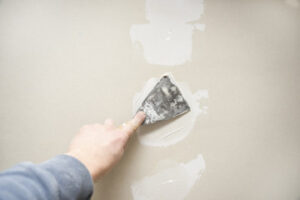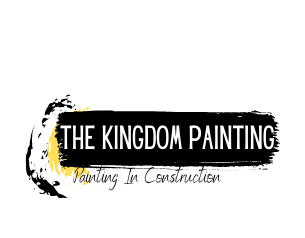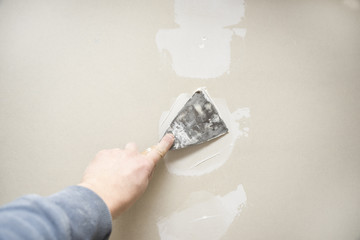When you have broken drywall, or it has been damaged, you need to make a plan to fix the problem. There are different ways to do this. Whether you use a spackle or joint compound to fix the area, you must know what to do.
 A joint compound is a special mixture used to repair drywall and other gypsum panel joints. It comes in a variety of forms. The best type for your project will depend on the size of your hole. If you have a larger hole, consider spackle. Spackle is a blend of binders and gypsum. The resulting mixture is easy to apply and quicker drying than the joint compound.
A joint compound is a special mixture used to repair drywall and other gypsum panel joints. It comes in a variety of forms. The best type for your project will depend on the size of your hole. If you have a larger hole, consider spackle. Spackle is a blend of binders and gypsum. The resulting mixture is easy to apply and quicker drying than the joint compound.
You can also use mud instead of joint compound. Drywall mud is easy to sand and is a great solution for small holes. However, you will need to be careful when applying it as it can shrink considerably when dry. Alternatively, you can choose to paint your wall to match the original color. This will ensure that the repaired patch will be invisible.
Spackle and joint compound are two types of fillers that are used to repair drywall. They are both effective in repairing dents and cracks. The key is to choose the right product for the job. Whether you decide to use spackle or joint compound, you’ll need to make sure it’s applied properly. Spackle is a paste-like substance that’s mainly composed of gypsum. It’s a good choice for small repairs, but isn’t suitable for large holes. If you’re trying to repair a large hole, you should consider using drywall mud instead.
Unlike joint compound, which is used to fill large holes, spackle is meant for smaller jobs. This means it’s less messy to apply and dries quickly. There are several brands of spackle available. You can purchase it in small tubes, or in pre-mixed tubs. Using a putty knife, you can spread it onto the area. Once it’s dried, you’ll want to sand it smooth.
In order to fix a drywall hole, you must first cut a piece of drywall to fit the hole. You’ll also need to apply some joint compound to it. The process is relatively easy. Most drywall damage involves small holes or scrapes. These can be repaired easily with basic tools and materials. But, if the hole is too large to be repaired, you’ll have to cut a new section of drywall.
If your drywall is damaged, you can use a drywall saw to cut it out. This will make it easier to remove later. Be sure to use firm strokes. If you want to make the hole smaller, you can apply joint compound or spackle to it. Make sure to leave the edge of the hole clear of drywall. Also, be careful to clean up any leftover dust from the process.
Corner bead repair is necessary if your corner bead has been damaged or dented. This metal piece is used to protect the two sheets of drywall at the corner of an outside wall. If the bead is dented, the drywall is likely to crack. However, there are a few things you can do to fix this issue.
Corner bead repair starts with removing any loose material. You can do this by using a drywall putty knife or a straight-blade screwdriver. It is important to work slowly so you don’t damage the existing bead. Once you have removed the loose material, apply a thin layer of spackling compound on the damaged area. This will provide a smooth surface for you to apply the drywall mud.
Painting the repaired area after drywall repair is a good way to revitalize the interiors of your home. However, it’s important to make sure you are not painting over any existing blemishes. Leaving them behind can leave your wall looking dirty and unfinished. To get the best results, it’s a good idea to hire a professional. A reputable company will not only take care of the damage, but give you the quality paint job you expect.
If you’re planning on painting your walls, using a quality primer is a good idea. This will help your new paint stick better to the drywall and blend in better with the rest of the room. Getting a mud repair is also a good way to give your wall some texture. Using a roller to apply the mud will help distribute the repair more evenly.

